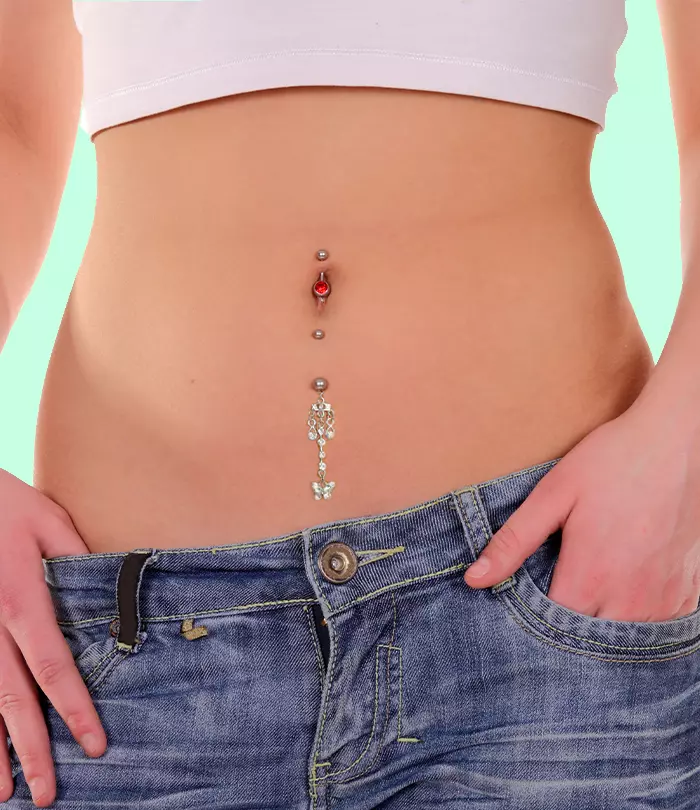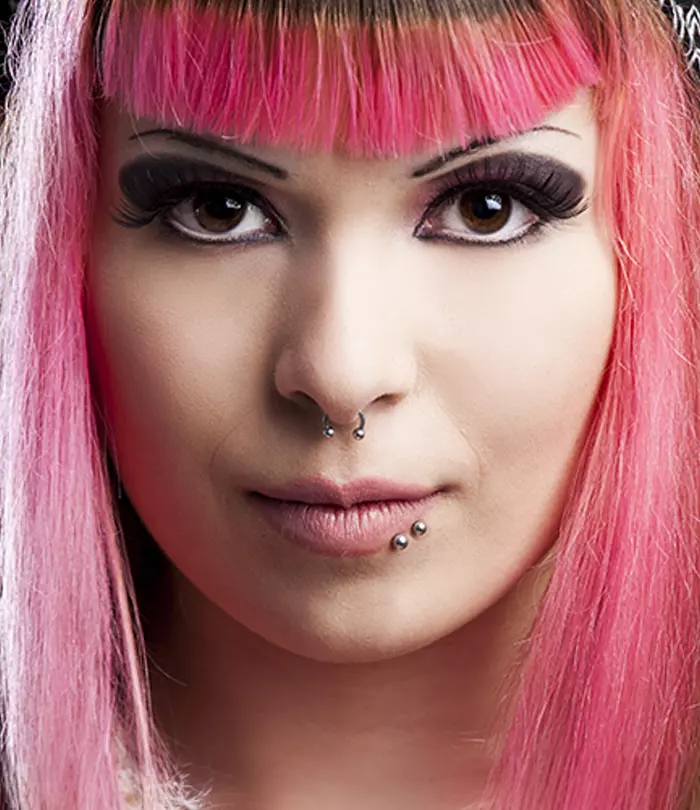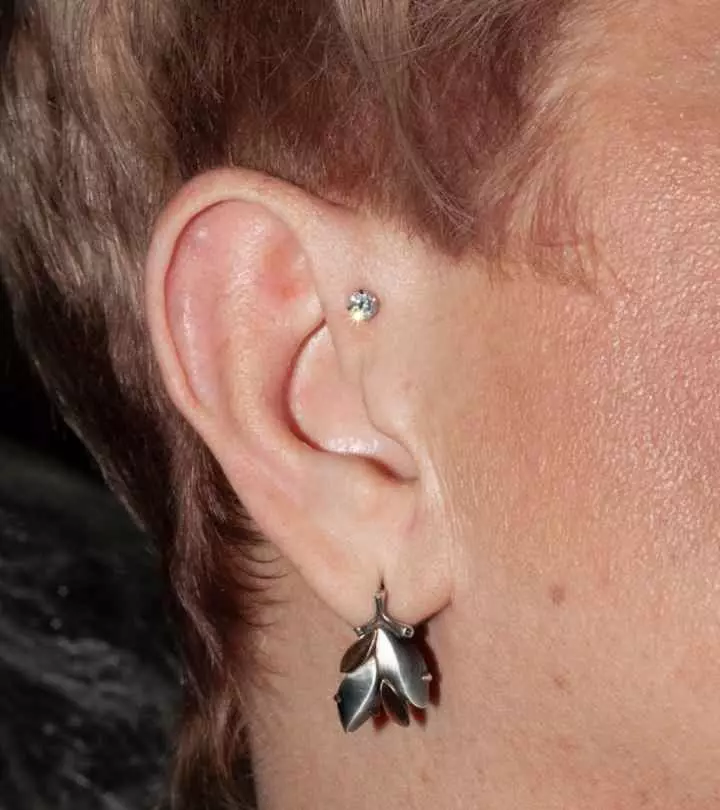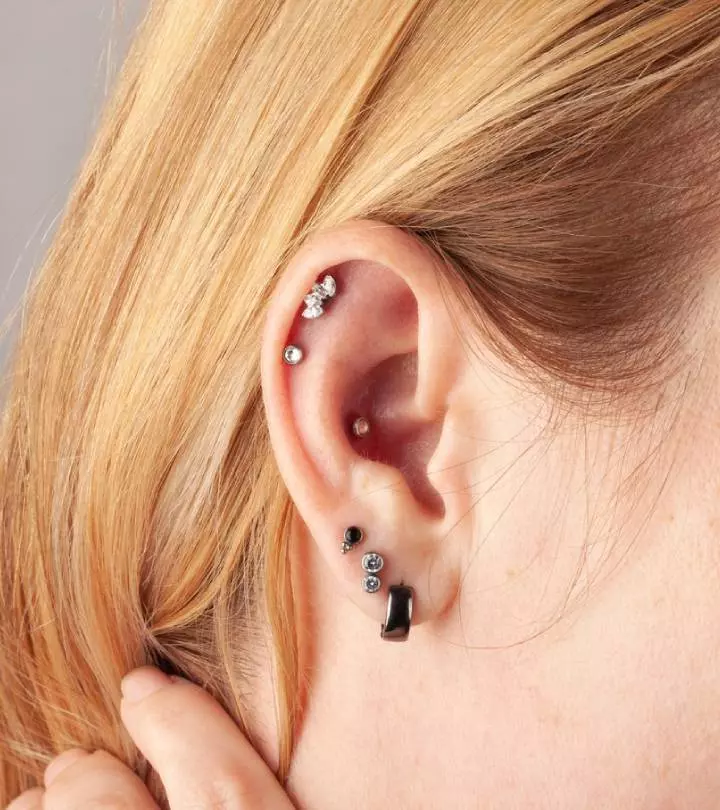Belly Button Piercing After Pregnancy: Is It Safe?
One need not compromise on safety to embrace the journey of motherhood with style.

Image: Shutterstock
Thinking of adding some sparkle to your new-mom glow by getting a belly button piercing after pregnancy? Some women get it done as a marker of their transition into motherhood and to satiate their desire for self-expression in that moment. While the idea of a navel piercing can be appealing, it is important to approach it with caution, especially because the body undergoes various changes during pregnancy that may lead to potential complications later on (1). Thus, it is advisable to speak with a healthcare professional for their advice before getting this piercing. In this article, we discuss how to take care of a navel piercing after pregnancy, how to fix a stretched belly button piercing, and ways to get rid of a piercing scar. Read on!
In This Article
Is It Safe To Keep A Belly Button Piercing After Pregnancy?

Yes, keeping a belly button piercing during pregnancy and after giving birth is usually safe if the piercing is fully healed. However, it is important to be aware of certain potential changes, such as the stretching of skin around the navel due to the expansion of the abdomen during pregnancy. It is important to maintain good hygiene, keep an eye out for signs of infection, and follow a proper aftercare routine. If you have any further concerns, consult with a professional body piercer or healthcare provider for guidance.
Although maintaining a belly button piercing after pregnancy is generally safe, there are a few things to think about to make sure you are comfortable and reduce the risk of complications. Please consider the following points.
- Consider the type of jewelry you are going to use. Jewelry that is longer and more flexible may more easily accommodate changes in belly size. Choose jewelry made of surgical stainless steel, white gold, or 18-karat gold. These metals are considered to be durable and less prone to corrosion, hypoallergenic, and reduce the risk of allergic reactions. Also, make sure that the jewelry does not pose a risk to you or your baby during nursing because all body jewelry is not created equal (2).
- There is a chance the piercing will move or stretch as your belly grows larger during pregnancy. Pregnancy-related movement or stretching of a navel piercing may result in small tears in the skin surrounding the piercing. These tears provide entry points for bacteria, increasing the risk of infection.
- Pregnancy can affect the elasticity of the skin around the belly button. The appearance and comfort of the piercing may be affected if the skin does not return to its pre-pregnancy state after giving birth.
- Re-inserting the jewelry after childbirth may be difficult if you decide to take off the jewelry during pregnancy. It is generally safe to keep a pre-existing belly button piercing during pregnancy unless it causes any discomfort.
- Keeping your belly button piercing after pregnancy comes with the need for precise care. Discover how to care for your belly button piercing after pregnancy in the next section.
Key Takeaways
- The body undergoes significant changes during pregnancy, so give it enough time to heal before attempting to change or reinsert piercing jewelry.
- Choose high-quality jewelry that is made with hypoallergenic materials to minimize the risk of infection and irritation.
- Follow proper instructions on cleaning the piercing, avoid harsh chemicals like hydrogen peroxide, and opt for a gentle approach to prevent pressure on the healing tissue.
It is essential to take care of a postpartum navel piercing to prevent bacteria buildup in the area, which may lead to infections. Here are some guidelines to help you take care of your belly button piercing after pregnancy:
- Clean your navel piercing with a non-alcoholic, fragrance-free cleanser.
- Avoid touching your piercing with dirty hands.
- Be gentle when cleaning the area surrounding the piercing.
- When applying the cleaning solution, use a cotton swab or pad and stay away from using harsh chemicals that can irritate the area.
- Although belts or belly wraps are often used after giving birth, exercise caution when placing them near a navel piercing.
 Quick Tip
Quick TipA different set of measures, however, may be required to deal with the stretching of the navel piercing that occurs as a result of pregnancy. Find out more details about it in the following section.
How To Fix A Stretched Belly Button Piercing After Pregnancy
It is common for individuals who have given birth to notice physical changes in their bodies, including the stretching of a belly button piercing. Stretching may lead to a larger piercing hole and loose skin that no longer holds your belly button rings. Here are some ways to take care of a stretched belly button piercing after pregnancy:
- Switch to shorter and more flexible piercing jewelry to help reduce pressure on a stretched piercing. You can also replace a metal piercing with a piece of bioplastic jewelry.
- Use a natural oil, such as vitamin E or jojoba, to gently massage the region to keep the skin supple and hydrated. This may also improve the stretched-out look of the skin.
- You can consider using piercing retainer bends if the piercing is painful or at risk of tearing. This may help protect the piercing.
Avoid putting excessive pressure on the piercing and making movements that can aggravate or strain the area. - Take into consideration using silicone discs made especially for stretched piercings. These can lessen the strain on the piercing and offer additional support.
- Consult an experienced piercer to evaluate the situation at hand. They can offer advice on whether the piercing needs to be removed temporarily or if there are alternative ways to help it get back to its original state. If you are dealing with major stretching or discomfort from your belly button piercing, it’s a good idea to consult a healthcare professional for safe treatment options.
- To restore the appearance of the belly button as well as a piercing on it, some women choose to undergo tummy tucks or umbilicoplasty (cosmetic procedures focused on the alteration or reconstruction of the belly button) after their pregnancy (3).
 Pro Tip
Pro TipExamining practical methods for reducing or getting rid of any scars left behind by a belly button piercing is just as important. Scroll down to learn effective ways to improve navel piercing scars after pregnancy.
How To Get Rid Of A Belly Button Piercing Scar After Pregnancy

Your abdomen may go through some changes during pregnancy, which may leave you with a scar around your belly button piercing. Accidental trauma to the piercing site, allergic reactions, improper piercing technique, infection, and poor aftercare measures may cause belly button piercing scars. While they may not totally disappear, there are a few ways you can try to lessen how noticeable they are after pregnancy. Here are some suggestions:
- Over time, scars may naturally fade away. If you allow your body enough time to heal, the scar can naturally fade.
- Gently massaging the scar tissue around the piercing area may help break down collagen fibers and improve the appearance of the scar (4).
- Anecdotal evidence suggests that applying vitamin E oil to the scar may help promote skin healing and reduce the appearance of the scar.
- Applying silicone sheets or gel to the scar may help soften and flatten it (5). However, follow the product instructions for proper usage.
- Applying pure aloe vera gel to the scar may help promote healing and reduce inflammation (6).
- Consult a dermatologist if the scar bothers you and does not go away. In order to reduce the appearance of the scar, they may undertake treatments such as laser therapy or dermal fillers.
Keep in mind that every person’s skin heals differently, and results can differ. For individualized guidance, it is recommended to speak with a dermatologist or other medical professional if you have concerns or questions regarding scar management.
Jaime, a blogger, shared her belly button piercing experience in her personal blog. She writes, “I was fortunate to not get any stretch marks except a little one in my belly button piercing that I can’t really see anymore. From day 1 of my pregnancy, I rubbed coconut butter into my ever-stretching beach ball belly (i).”
We addressed certain concerns regarding how to effectively get rid of scars from a pre-existing piercing. It is crucial to also be aware of the common risks associated with getting a fresh navel piercing after pregnancy. Scroll down to learn about possible health risks.
Risks Of Getting A Belly Button Piercing After Pregnancy

Whether getting a belly button piercing after pregnancy is safe may depend on a few factors. There may be some potential risks you need to be aware of. The following are some possible risks of obtaining a belly button piercing following pregnancy:
- Pregnancy is associated with changes in the immune system, which can cause differential reactions to germs (7). It may be more difficult to gauge how the body might react to a piercing right after pregnancy. It is best to consult a doctor to get a personalized opinion before making a decision.
- After pregnancy, the skin around the belly button may be more sensitive, increasing the likelihood of allergic reactions to metals commonly found in navel jewelry, such as copper, nickel, or alloys.
- The jewelry itself may cause discomfort or irritation to the baby while nursing, especially if it sticks out or rubs against the skin.
Sensitivity to the skin might increase during the pregnancy. Some individuals may experience increased discomfort and pain during the procedure of belly button piercing due to that. - Skin stretching during pregnancy can sometimes lead to changes in skin elasticity. This may increase the risk of piercing rejection, where your body pushes the belly rings out.
- Individuals with a family history of keloids are prone to keloid formation, which is an overgrowth of scar tissue (8). Keloid is an abnormal response to injury.
Hence, it is essential that you clean the piercing and follow your piercer’s aftercare instructions to avoid the risk of infections.
After acknowledging the possible risks linked with getting a belly button piercing after pregnancy, individuals who previously had a piercing may consider the feasibility of re-piercing following childbirth. Scroll down to learn more about it in detail.
Can You Re-Pierce Your Belly Button After Pregnancy?

Re-piercing after pregnancy is usually safe, but you should wait until your body recovers from the experience of childbirth. Also, it is essential to consider a multitude of factors before doing so. Here are some points to keep in mind:
- During pregnancy, your body goes through a lot of changes, and your belly button may stretch. So it is important to give your body enough time to recover after giving birth before getting any piercings.
- Seek advice from a qualified piercer before getting belly button re-piercing. They can examine the area, talk about any changes that might have happened during pregnancy, and offer advice on whether getting a piercing is appropriate.
- Your body may become more prone to infections while it heals from childbirth. Hence, to reduce the possibility of difficulties, make sure you adhere to the piercer’s recommended navel piercing aftercare process guidelines.
Note:
Always consult an experienced piercer in a reputable piercing studio for any piercing. They can provide personalized advice based on your specific situation.
After experiencing the transformative journey of pregnancy, many individuals wonder about the possibility and timing of piercing their belly button. Find out how soon you can get it after pregnancy in the next section.
How Soon Can I Get A New Belly Button Piercing After Pregnancy?
After childbirth, the body undergoes postpartum healing and recovery. Getting a new belly button piercing after pregnancy is generally a personal decision, and the best time to do so can vary from person to person. However, it is essential to consider a few factors before getting a new piercing after pregnancy:
- It is advised to wait about three months after giving birth before getting a belly piercing so that your body has time to heal. Pregnancy and childbirth can put stress on the abdominal area, and the body needs time to recover from the changes it undergoes during pregnancy.
- Any new piercing comes with a chance of infection (9). It is advisable to wait until after you have finished nursing as getting pierced at this time may lead to a higher risk of complications.
- It is necessary to wait to get any new piercings until after you have fully healed from any birth-related operations, such as an episiotomy or C-section.
It is advised to get clearance from your healthcare provider and consult a qualified and reputable piercer to ensure a safe piercing experience. They can evaluate your medical history, take into account any difficulties you may have had with pregnancy or childbirth, and offer advice on when to get a new belly button piercing.
The journey of belly button piercing after pregnancy is a personal choice that requires careful consideration and attention to one’s own body. The body undergoes major changes throughout pregnancy, so it is important to pay attention to one’s body, consider any potential discomfort or pain, and make informed choices. If you experience signs of infection, including prolonged redness or allergic reactions, it is recommended to consult with an experienced piercing expert or healthcare professional for appropriate treatment.
Frequently Asked Questions
Is it safe to get a belly button piercing if I had a C-section?
Getting a belly button piercing after a C-section is generally safe, but it is important to consult with your healthcare provider before proceeding. As the piercing is inserted beneath the skin, it is important to make sure that your abdominal muscles have healed enough for a C-section, which requires an incision through the muscles.
Will my belly button piercing look different after pregnancy?
A woman’s body experiences many changes during pregnancy, such as increased weight, skin stretching, and changes in hormones. These changes may affect how a belly button piercing looks, while each individual may experience different levels of impact.
Can I use my old belly button piercing jewelry after pregnancy?
The type of material used, the degree of healing, and any complications experienced during pregnancy all play a role in whether or not old belly button piercing jewelry can be reused after pregnancy. It may be safe to wear old jewelry if the piercing has healed completely and there were no problems. However, consult a piercer or healthcare provider for guidance on safety.
What if my belly button piercing becomes infected post-pregnancy?
If your belly button piercing becomes infected post-pregnancy, use sterile saline solution or antibacterial soap to keep the piercing clean, use a warm compress or warm water to reduce the risk of infection, try using antibiotic ointment, and avoid taking off jewelry. If the infection continues, avoid tight-fitting clothing and always choose loose-fitting clothing, practice good hygiene, and see a doctor for individualized guidance or an antibiotic prescription.
Wondering about how to get a navel piercing after pregnancy? Watch this informative video and learn what happens to navel piercings post-pregnancy. Also, learn the inside story on changes, challenges, and care essentials.
Personal Experience: Source
StyleCraze's articles are interwoven with authentic personal narratives that provide depth and resonance to our content. Below are the sources of the personal accounts referenced in this article.
(i). 25 things my father-in-law never wanted to know about me post-pregnancy
https://rabitstew.wordpress.com/2012/08/14/25-things-my-father-in-law-never-wanted-to-know-about-me-post-pregnancy/
References
Articles on StyleCraze are backed by verified information from peer-reviewed and academic research papers, reputed organizations, research institutions, and medical associations to ensure accuracy and relevance. Read our editorial policy to learn more.
- Physiological changes in pregnancy
https://www.ncbi.nlm.nih.gov/pmc/articles/PMC4928162/ - Immunological mechanisms of metal allergies and the nickel-specific tcr-pmhc interface
https://www.ncbi.nlm.nih.gov/pmc/articles/PMC8535423/ - Umbilical reconstruction: Different techniques, a single aim
https://www.ncbi.nlm.nih.gov/pmc/articles/PMC7233773/ - Update on postsurgical scar management
https://www.ncbi.nlm.nih.gov/pmc/articles/PMC4961501/ - Silicone gel for scar prevention
https://www.ncbi.nlm.nih.gov/books/NBK586090/ - Topical application of aloe vera accelerated wound healing, modeling, and remodeling: An experimental study
https://pubmed.ncbi.nlm.nih.gov/25003428/ - The immune system in pregnancy: A unique complexity
https://www.ncbi.nlm.nih.gov/pmc/articles/PMC3025805/ - Keloid
https://www.ncbi.nlm.nih.gov/books/NBK507899/ - Complications and hazards associated with body piercing: A narrative review
https://pubmed.ncbi.nlm.nih.gov/37916624/
Read full bio of Anastasiia Gatsko
Read full bio of Vaishali Sinha
Read full bio of Subhrojyoti Mukherjee
Read full bio of Shreya Mukherjee



























Community Experiences
Join the conversation and become a part of our empowering community! Share your stories, experiences, and insights to connect with other beauty, lifestyle, and health enthusiasts.